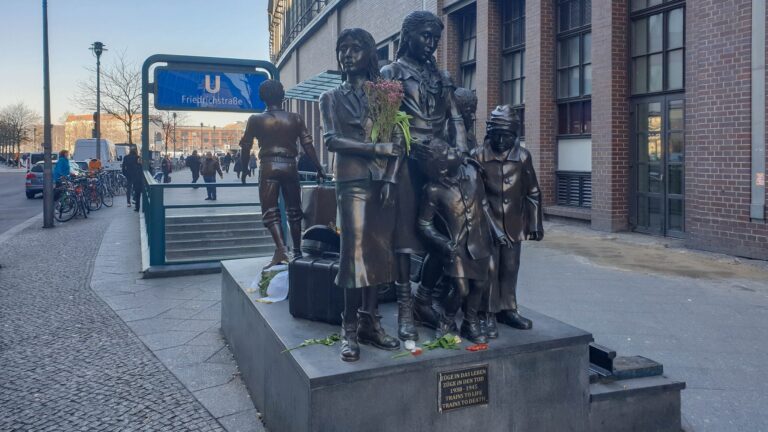Holocaust, WWII & Third Reich Sites in Berlin
Berlin is still grappling with its role as the capital of a National Socialist Germany, which was responsible for World War II. Today, visitors to the city can explore certain remnants of the Third Reich and pay their respects at Holocaust sites. These include the Topography of Terror, which documents the history of the Nazi regime, and the Sachsenhausen concentration camp, located just outside the city. Visiting these sites is a sobering reminder of the atrocities committed during this dark chapter in history, and a way to honour the victims and ensure their stories are never forgotten.
Anhalter Bahnhof
Inaugurated in 1841, Anhalter Bahnhof was one of Berlin’s most important train stations. And known as the Gateway to the South. During the Nazi era, it is estimated some 500,000 people fled the country from here. From 1942 to 1945 over 9,600 Jews were sent from here to Theresienstadt, Czechoslovakia. In the final months of Second World War the building was destroyed. A new museum telling the story of exile will open on this site in 2026.


Berlin Story Bunker
The WWII bunker on Schöneberger Straße near Anhalter Station was intended to shelter up to 3,000 commuters in the event of an air raid on Berlin. Today it houses the exhibition ‘Hitler – how could it happen’. With text, historic photographs and film, on three of the bunkers’ five levels, the rise of and demise of Hitler is documented in 40 separate displays. The exhibition has the only model of the Führerbunker. This self-guided tour takes between two and three hours.

Book Burning Memorial, Bebelplatz
Formerly known as Opernplatz (due to the State Opera), this public square had its name changed to Bebelplatz on 31 August in 1947 as a reminder of the Nazi book burnings that began here on the night of 6 May 1933, with the burning of books from the Institute for the Science of Sexuality library. A few nights later this event escalated into similar such actions in university towns around the country on 10 May 1933. An estimated 20,000 books were burned here. A plaque marks the site, as does the installation The Empty Library by Micha Ullman, where a glass plate has been set into the cobblestones that looks onto empty bookcases large enough to hold 20,000 book.

Gleis 17 Memorial, Grunewald Station
The goods platform station of Grunewald S-Bahn is where an estimated 50,000 Jews from Berlin were transported to their death. From here, one of three deportation stations in Berlin, Jewish citizens were deported to labour and concentration camps in Riga, Warsaw, Auschwitz-Birkenau and Theresienstadt. Platform 17, or Gleis 17, has a metal installation that preserves the platform and records the dates of the departures, the number of people and their destinations.

Nazi Forced Labor Documentation Center, Berlin-Schöneweide
During WWII 12 million people from around Europe were forced to work in the German economy. Labouring and living under appalling conditions. They were housed in specially constructed camps of barracks. Only one such camp has survived in Berlin, in the south east of the city. Over 400 forced labourers from Italy were among the detainees here. Today the camp is a documentation centre on Nazi forced labour. Poignant and moving exhibitions tell the stories of the men and women incarcerated here and elsewhere in Berlin during the war.

Reichstag
Built between 1884 and 1894, this iconic building with its glass dome has been home to the parliament of the German Empire, the Weimar Republic and for the National Socialists – until it was destroyed by fire in 1933. Renovation was completed in 1999, and it is now the second most visited attraction in Germany. It is possible to climb to the top of the dome, visit the Plenary Chamber and have a meal at the Rooftop restaurant. The Reichstag is free to visit, but advance registration is required. Take a guided tour that includes registration.

Schwerbelastungskörper - Heavy Load Exerting Body
Hitler’s megalomaniacal plans for a new Berlin at the heart of a Greater Germanic Empire included monumental structures, including an enormous triumphal arch. French forced labourers were required to create a load bearing body to test the soil conditions for the weight of the arch. They built a solid concrete cylinder, 21 m in diameter, 14 m high, and extending 18 m into the ground. A viewing platform allows you to see this sole surviving remains of Nazi urban planning for all angles.

Topography of Terrors
Topographie des Terrors in central Berlin is an indoor and outdoor exhibition space detailing the horrors of the Nazi regime. The site was the headquarters of both the SS and Gestapo. Who not only planned many atrocties here, but so too were prisoners tortured in the Gestapo cellar. Before May 1933 this was the Prinz-Albrecht-Palais. The area was heavily destroyed at the end of the war, but recent excavations have uncovered the cellars and other basement elements.


Trains to Life - Trains to Death
Just outside Friedrichstraße train station in Berlin is the Trains to Life – Trains to Death bronze installation by the Israeli architect and sculptor Frank Meisler. The memorial depicts two groups of children that represent the contrasting fate of Jewish children during the Nazi era. On 1 December 1938, 190 children departed from Friedrichstraße station for England under the kindertransport scheme. Many more children were deported to death camps around Europe.











